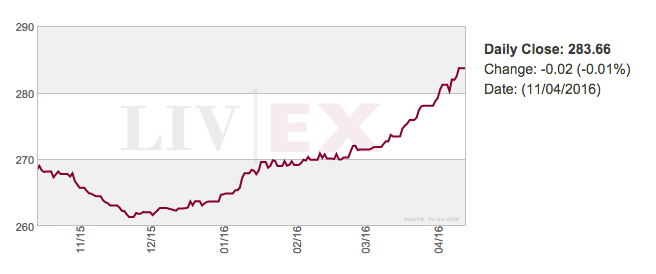Wealthy fine wine investors have been mixing business with pleasure for years, with heady financial rewards. But the wine market is changing. Factors such as a growing Asian customer base have opened up the market to a new audience of investors.
No longer do you need to spend exorbitant amounts on the very finest Bordeaux, nor must you have an expert nose or even your own cellar to get in on the game and achieve high returns, say fine wine investment portfolio managers.
But on removing the rosé-tinted sunglasses, investors might well be wary that the Financial Conduct Authority (FCA) does not regulate the market.
Also, with effect from January 1 2014, the FCA
banned the promotion of unregulated collective investment schemes to ordinary investors, which includes wine investment funds.
Here’s what you need to know before diversifying into fine wine, according to Philip Staveley, Director of Amphora Portfolio Management.
What are the potential rewards and expected risks?With fine wine, you have quite an exotic combination: diminishing supply and increasing desirability. In any market place, for any goods, anywhere in the world, where you have diminishing supply and increasing desirability (leading to increasing demand), you get upward pressure on the underlying asset price.
The Liv-Ex Fine Wine 100 Index helps holders and potential investors track price movements among the world’s most sought-after wines. Over the past 30 years, the Index has returned around 14% per year. Over recent times, the market has broadened dramatically, so with judicious switching, returns in excess of that are possible.
Risks come by way of unregulated investments, which – be they fancy coloured diamonds, air over Bolivian rainforests or stamps accidently printed upside down – attract villains and crooks. Be warned: wine investment has had its fair share. Spotting them can be difficult.
Who are the market drivers – the sellers and promoters?Since a severe correction in the Left Bank (of Bordeaux) wine market by as much as 40% in 2011, many of the less well-established fine wine brokerages have failed to survive, so there are fewer active promoters currently.
That said, in the past, the performance of the market has spoken for itself, and investors have found it, rather than brokers finding investors.
What have been some of the big trends in the market?Since 2011 and the Left Bank correction, Burgundy, in particular, has picked up the baton, while wines from Tuscany and the US have also come to the fore. As a result, the marketplace is much broader than ever before.
At the same time, Left Bank wine prices have now rebounded strongly. The Liv-Ex 50 (representing only First Growths, also known as ‘Premier Crus’) has risen by 7.2% year to date. See the chart below for market movements since late 2015.

As far as low interest rates are concerned, in theory they should stimulate inflation, which would customarily drive asset prices higher. In the case of the fine wine market, however, the past 30 years have seen a series of secular changes, which have been of far greater influence.
In the period between the end of World War II and the end of the 1980s, steady global economic growth and inflation saw prices rise on a consistent basis, leading to the oft-cited ‘non-correlation’ (to other asset classes) arguments trotted out in favour of fine wine investment.
Since then, though, the entry first of Japanese investors in the 1990s, then Chinese investors from around 2004 completely changed the landscape by adding significant new market participants into the mix.
What is the experience like for holders?It depends on how long you have ‘held’ fine wine for, and who you have listened to. Holders of First Growths for ten years are still sitting on healthy returns, despite the 2011 correction.
The huge rises up until then, however, attracted many people looking for easy money, and it is they who have had a more painful experience. By using well-reasoned switching strategies, though, holders can shield themselves from the worst of the downdraft.
In terms of the costs of holding, storage and insurance, charges vary between the warehouses, usually from £10 per case per year to as much as £20. This charge is of particular significance. It means there is no point investing in wines costing much below £750 per case, because storage charges then erode investment returns. Remember, it costs the same to store a case costing £100 as one costing £10,000. In the latter case, the storage charge becomes negligible (from an investment perspective). A coherently constructed portfolio would take all this into account. As it happens, most investment grade wines cost in excess of £1,000 per case, anyway.
In relation to measuring performance, there are a variety of indices run by Liv-Ex that give a perfectly fair representation of what is happening in all geographical sectors of the market.
What are the regulatory and tax considerations when investing in wine?The market is currently unregulated by the FCA, and HM Revenue & Customs (HMRC) considers wine a ‘wasting asset’, so investments are not subject to capital gains tax. The only area regulation touches is in respect of the bonded warehouses – customs-controlled storehouses for imported goods until the duty owed is paid – which are regulated for VAT purposes.
Inheritance Tax (IHT) does apply. HMRC said in a 2010
newsletter: “It is clear that a wine cellar must be valued at its open market value for IHT purposes at the time of the relevant occasion of charge.”
For these purposes a ‘wine cellar’ constitutes wine forming part of an estate over the IHT threshold, regardless of how it is stored or in what quantity.
What are the considerations related to funds?It is possible to buy exposure to the market through a fund, but most are too small to withstand the deleterious effects of substantial withdrawals. You would also be exposed to the performance of a third-party manager and none have developed a creditable track record as yet.
It is advisable to have your own portfolio, which is exempt from capital gains tax.
What is the shelf life of the investment? Most investment-grade wines last at least 30 years and often much longer, provided they are correctly stored.
As previously mentioned, HMRC deems fine wine a ‘wasting asset’. For its purposes, fine wine is considered unlikely to last for more than 50 years. However, in practice there are plenty of examples of wines lasting considerably longer.
How is climate change affecting the industry and investment in it?The fine wine market is considerably affected by climatic considerations. If, for example, Bordeaux were to suffer drought conditions, it would not be able to produce high-quality wine on a regular basis. Of course, this would drive up prices of existing high-quality vintages.
In addition, climate change has resulted in the south of England enjoying a climate traditionally associated with Champagne, hence the epidemic of sparkling wine production there. It is obviously far too early to determine whether any of this is ever likely to be investment grade.
Meet the expert

After an impressive financial career at, among others, Smith New Court/Merrill Lynch and Deutsche Bank, and time spent as a freelance journalist, active private investor, and property developer, Staveley’s first investment in fine wine was in 1998. In 2012, he joined Amphora Portfolio Management, where he has been instrumental in enhancing its proposition and business model in the UK and across Asia.
What are the pricing and liquidity considerations? ‘Valuations’ can often be somewhat disingenuous. Investors are sent valuations that they think represent realisable value, when they actually represent replacement value. That’s because merchants’ bids are not advertised. There is no reliable resource for quoting the bid side of the equation, only the offer side.
Given the often-wide price spreads offered by the merchants, this can and does lead to misunderstanding.
Wine-searcher is a globally accessible website showing cost prices from merchants and dealers worldwide. The site makes it easy to see how much you should be paying at the point of entry. It is at the point of exit that the pitfalls exist, because, as mentioned above, merchant bids are not advertised. They can be as much as 30% below their offer prices, and are seldom less than about 12% below. Traditionally investors dealt through the merchants, and many still do. This is investment suicide, clearly, given the spreads. Dealing inside the spread, through certain avenues of supply and distribution, offers investors a much better chance of higher returns.
How volatile is the market?Traditionally, there has been very low volatility, but this changed when Asian consumers entered the market from around 2004 onwards. As highlighted above, volatility can be reduced by judicious switching within a portfolio.
Are there correlations with other asset classes?You will typically hear that there is little or no correlation. That was certainly true in the past, but the arrival of participants such as China has supported the argument that rising prosperity is likely to have a more significant impact than anything else. Logically, you have to feel pretty good about life to want to fork out £1,000 for a bottle of wine in a restaurant, and ultimately the wine has to be consumed for supply to diminish. Diminishing supply to the market is a key cornerstone of the investment dynamic.
What is the cost of buying/selling?At auction, you can easily pay a seller's fee of up to, or even more than, 20% and there is also a fee for purchase – again this can be as much as 20%. Only under special circumstances would an auction be the best route, for example, (former Manchester United manager) Sir Alex Ferguson's portfolio that contained signed bottles.
Opting to go with a wine investment portfolio manager is more prudent. The service they provide should include reports, appraisals, free switches and more. You have to be careful because some people offer a low fee but charge a massive markup on the wine. Portfolio managers should aim to deal at the best price, and will often do so at a discount to the merchant's offer price.
Selling can be a challenge because liquidity is an issue in certain cases. For example, the Burgundy wine Domaine de la Romanée-Conti is produced in such small quantities there is almost immediate scarcity, leading to very high prices. This is all well and good, but the market for people wanting to pay £100,000 for a case of wine is extremely thin.